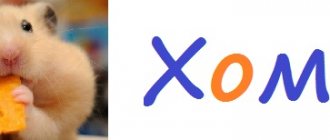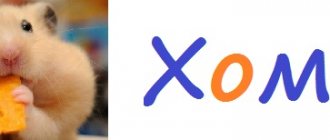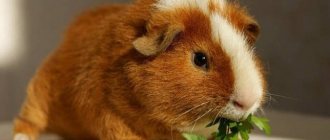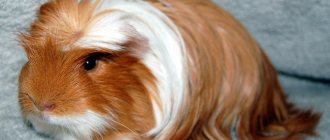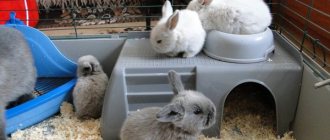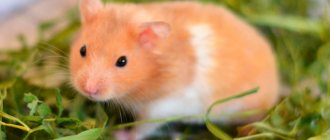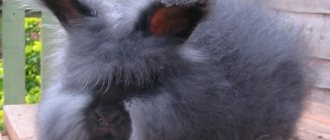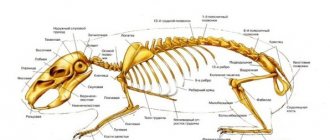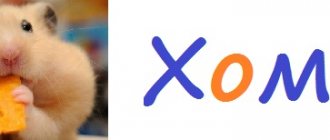The Crested guinea pig is a short-haired animal with a neat crest on its head, which is called a rosette. The breed itself is extremely interesting, leads an active lifestyle, is easy to care for, and is also extremely sociable. All these qualities attract people to get this animal. In this article you will learn all the advantages and disadvantages of this guinea pig.
Description of Crested Guinea Pig
This rodent has short hair, a cheerful disposition and a memorable appearance. These are significant advantages, which is why the breed is relevant among guinea pig lovers. Cresteds are similar to the English or American Self breed, but they have a distinctive feature - a rosette on the forehead.
There are two varieties of this rodent:
- English Crested. The rosette of this type is of regular shape - roundish and matches the main color of the animal.
- American Crested. This type has a white rosette of irregular shape in the middle of the forehead; the rest of the body should not be white.
Although these are different varieties, apart from the socket, they are for the most part similar.
The breed is not very popular in Russia and is found more often in Western countries, especially in Europe and the USA.
Appearance and dimensions
Due to the unusual growth of hair, hair to hair and as if it was combed with a damp comb, the Self guinea pig has won love on all continents. But the classic appearance is not the only merit of the rodent. The main advantage of the self is its ease of care, the peaceful nature of the animal and the amazing nepotism in the pride.
It is easy to distinguish a true “English” from a rodent of another species:
- Photo of the Self breed.
- The coat color is the same tone.
- A small knocked down body.
- Large head with a characteristic Roman profile.
- The ears are large and repeat the pattern of a rose petal.
- Large eyes, slightly protruding.
At a young age, piglets' growth slows down and only by the age of two do they develop into an adult animal.
Males are significantly larger than females, body weight reaches up to 1.8 kg; females rarely reach a kilogram. The length of the body can vary from 30 to 32 cm.
Buy a rodent at any pet store. In the nursery the price is from 1000 rubles. and may vary depending on the sex and age of the animal.
Appearance standards
This breed is smooth-haired and similar to Selfies, but Cresteds are judged according to different criteria:
- Body shape. An animal of this breed has a short body with good density, while the shoulders and neck should be higher according to the standard. The rodent has a slightly curved profile. The pig's head is short and also wide, and its size is more than 25% of the total body length. The breed has a dull nose.
- Ears. Large, without folds, and also hanging freely - this is how the ears of an animal should be. Their location is also important. Cresteds often have a distant landing and a horizontal position.
- Eyes. The breed has symmetrical, round eyes.
- Wool. In this matter, at exhibitions they check with the standards established for selfies. The fur should be smooth, soft, short and shiny. The length of the hairs should be in the range of 2-4 cm.
- Fur color. There are no strict requirements for coat color; many colors are allowed. The main thing is that there are no inclusions of rosette color on the rest of the body.
- Rosette color. The American White Crested should have a contrasting, clearly defined white rosette color, while the English Crested has a rosette color that matches the rest of the body.
- Rosette shape. There are slight differences between the species of this breed, but the rosette should be in the center of the forehead, roundish, wide and deep.
Bald
These unusual animals cannot be left aside. This breed was bred artificially, and has already become very popular, especially among people suffering from allergies. After all, their body has no hair. Today there are two breeds of hairless pigs: Baldwin and Skinny.
Skinny. They were born in the 80s of the last century. They have no fur, only a few hairs on their nose and paws. Accordingly, the skin of this pig breed is very soft and velvety. Skinny is distinguished by silver, black or even purple color. These animals have a wonderful appetite, so they need to be well fed.
Features of fur
The fur of Cresteds is shiny, soft, and also wavy. It fits tightly to the animal’s body. Due to its silkiness, the fur is less clogged. The healthy appearance of the coat depends on the pig's diet. If you feed your pet a balanced diet, the fur will always be in good condition.
The American species has fur colors: brindle, tortoiseshell, and also plain, except white. The English species can be seen in black. Gold, white and smoky colors.
You can often find two-colored individuals, but three-colored ones are extremely rare.
Character of the pig
The Crested guinea pig has a very good-natured and easy-going disposition. Cresteds are extremely curious and also really like people. They love to be in the hands of their owner, being scratched and petted. Each time they will greet you with a loud sound, this is their way of expressing joy.
Since pigs themselves are social creatures, they do not tolerate loneliness well. It is recommended to keep rodents in pairs, and if offspring are not planned, it is better to have same-sex ones. In general, pigs get along well with each other, but you should know some nuances. Females easily tolerate similar neighbors in any number, and males in some cases can quarrel with new pigs in order to defend their territory.
Rare breeds
In addition to the ordinary guinea pigs that are familiar to most people, there are breeds with a non-standard appearance that look very exotic and original.
Kui
These are real giants in the kingdom of guinea pigs. Adult pigs can reach a length of up to 50 centimeters, and the largest pigs weigh from 1.5 to 4 kilograms.
In their homeland, Peru, these animals serve as a source of meat, where they are raised on special farms. And although some hobbyists keep furry giants as pets, cooi are not the best pets, as they are quite aggressive and often bite their owners. In addition, the lifespan of kui is much shorter than their smaller cousins, and on average they live no more than 3 years.
Swiss Teddy
These rodents are considered the fluffiest among their short-haired counterparts. The main feature of Swiss Teddies is their “crimped” wool. Fluffy and curly animals look like a soft fur ball, and some owners compare their pets to dandelions.
Ridgeback
Very interesting representatives of short-haired pigs, which have a woolen comb along their spine, giving the rodents a somewhat aggressive and angry appearance.
At the moment, Ridgebacks remain a small and rare group of guinea pigs that have not received official registration as a separate breed.
Himalayan
Animals of the Himalayan breed have a specific and original appearance. In fact, they are albinos, who have pigmentation in certain areas of the body, in this case black or dark gray.
The animals' fur is completely white, and the ears, tips of the paws and the area around the nose are painted in a dark shade.
Like Ridgebacks, Himalayans are not yet recognized as a separate breed, and breeding work to consolidate their standards is still underway.
Tortoiseshell with white (cakes)
A rare and very valuable guinea pig among breeders, on whose body black, red and white spots alternate in a certain way.
Unlike ordinary tri-colored “turtles,” the tortoiseshell-and-white breed has an interesting checkerboard-like pattern on its back, formed by even colored squares. Because of this three-layer effect, the animals are affectionately called “cakes.”
Lunkaria
A relatively new breed that has not yet become widespread. Lunkaria have a long luxurious coat, and each strand is curled into a tight, slightly harsh curl. And, if in other curly pigs the hair straightens out when combed and becomes simply fluffy, in lunkarias after such a procedure the strands curl up again into a tight curl.
Curley
These beautiful animals are similar to curly lunkarias, as they also have tight, coarse curls. The only difference between them is that the Curlie has shorter hair. Thoroughbred individuals have dense curly fur, the fur on the belly is also curled, and there are always whiskers on the cheeks.
Mini-yak
One of the recently bred and rarest breeds. These delightful animals combine the features of three breeds: the long hair of the Peruvians, the rosettes characteristic of the Abyssinian pigs and the hard, slightly curly fur of the Rex.
The mini-yak has long strands of hair sticking out in different directions due to the vortices that are formed, and the bangs fall over the eyes or to the side, so the rodent looks a bit like a disheveled parrot.
Somalia
A new and very rare breed that is just waiting for official recognition. Somalis look like Abyssinians, as they have rosettes on their bodies, but the structure of their coat resembles the curly fur of the Royal Rex.
All types of guinea pigs are so different, but they have one thing in common: they are extremely trusting, affectionate and gentle pets
And it doesn’t matter at all what length or structure the fur of a cute rodent is, because in any case, the little animal needs love, care and attention
Conditions of detention
Considering the size of the rodent, you should choose a high and spacious cage. A good option is one that has a plastic bottom and a removable ceiling.
Since pigs are very active, it is recommended to place some obstacles or toys in the cage. It is also recommended to let the animal out of the cage to run around. The main thing is to carefully monitor the safety of your pet while walking.
Rodents' teeth continue to grow throughout their lives, so it is important to take this feature into account and place a mineral stone in the cage. Without it, the animal will begin to gnaw everything around it, including the house and the feeder. If your Crested guinea pig cannot grind down its teeth, you will need to visit the veterinarian frequently.
Rex
A characteristic feature of this variety of short-haired guinea pigs: thick, curly and very dense hair, the length of which is 17 mm. The wool stands vertically, without tilting or bending. The muzzle is decorated with winding mustaches.
This variety was first described at the beginning of the 20th century, but was formed as a breed much later. The entire rex population came from one litter of curly-haired guinea pigs born in 1975.
Disadvantages: long hair (longer than 2 cm), “breaks” along the spine, elongated body, light bones, straight mustache, damp lower eyelid.
In the photo: Rex guinea pig
Hygiene and coat care
The pig of this breed does a good job of caring for its fur. She uses her claws and teeth to clean and comb the fur to look great. However, during shedding, you should help your pet by combing the fur with a special brush a couple of times a week. Instead of bathing the rodent, you can simply wipe it with a dry cloth from time to time.
Health and nutrition
English and American Cresteds are herbivores, which is why their diet should include fruits, vegetables, and plenty of grass or hay. Fiber and carbohydrates are the basis of rodent nutrition.
A rodent’s body cannot produce vitamin C on its own, which is why it is necessary to provide it to the animal in the required dose. Modern foods contain the required intake for a rodent, so they are required for purchase. We must not forget about vegetables that contain a large amount of this vitamin: cabbage, lettuce or bell peppers.
It is important to remove leftover food from the cage every day and wash the feeder twice a week.
Pigs of this breed have good health and rarely get sick.
Owner reviews
Natalya, Russia, Aleksandrovsk
My husband and I chose a Crested guinea pig as a pet for our children. They called it Funtik. When we brought him home, it turned out that the animal was very scared. We had to gradually adapt it to new conditions. It took us 3 days to tame it.
Take it in your hands carefully, but you can’t hold it for a long time, return it to its place, and after a while you can pick it up again. Be sure to pet them, put them on the sofa with you, cover them with a blanket. This will be a kind of home for the pig, he will no longer be afraid of the new environment. You will hear a quiet purring.
It is important to consider that these are herbivores. We feed him fruits and vegetables. In summer he loves to eat grass, and in winter he loves to eat hay. You should not experiment on guinea pigs in terms of food, otherwise the animal may die.
We only walk with him when it’s warm outside. He doesn’t run away from us, he likes to walk on the grass. On cool days, walks take place in the apartment.
I read that these little ones live for about 8 years, but I heard from friends that they live only 3-4 years. I think it all depends on the conditions in which the animal is kept and its diet.
Ekaterina, Russia, Moscow
Our Lisa is smooth-haired, with a charming “crown” on her head. Breed: American Crested.
Very sweet, kind creature! She is affectionate and tame. She loves to be picked up and stroked.
Many people get guinea pigs for their children. I am categorically against this trend. A child can easily harm the baby, and she will only squeak, so much so that no one can hear her. Guinea pigs are quite fragile, delicate creatures. Falling is harmful to them; they should not be squeezed too hard or twisted upside down. This could all end badly for her.
Caring for them is easy, but it requires money and time. Guinea pigs need to be fed fruits and vegetables, which is quite an expensive proposition these days.
Crested guinea pigs are considered to be a good option for new breeders. In addition, it is an excellent pet, affectionate, gentle and funny.
